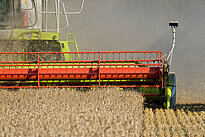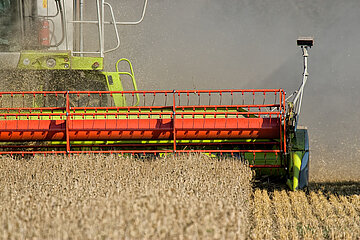Development of large scale farming in transition economies: The role of institutions
02 October 2019
Over the past 30 years, the development of agricultural sector in transition countries such as Kazakhstan, Russia and Ukraine has been marked by the rise and rapid expansion of large farming structures known as agroholdings, which operate enormous farmland areas of hundreds of thousands of hectares.
In this context, studies and expert opinions point to a decisive role the institutional environment of post-Soviet countries plays in the evolution of agroholdings alongside an ‘objective’ factor of growing global demand for food, feed and fiber. Generally, two levels of institutions bear responsibility for any kind of agricultural transformation: (i) embedded or informal institutions shaped by society (traditions, beliefs, and customs); and (ii) formal institutions including rules (laws, policies, markets), implementation of rules (governance institutions) and institutions of resource allocation and employment. How did these factors trigger the emergence of agroholdings? Are these factors similar or unique across countries? The present article attempts to answer these questions in the context of Russia, Ukraine and Kazakhstan – the post-Soviet countries in which agroholdings are most widespread.
Russia
Private land ownership was legitimized in Russia in 1991. However, a number of land regulations restrained the land market up to 2002 when a land law was passed and all land transactions were permitted. Since then, the number and size of agroholdings in Russia started increasing rapidly. As of 2003, over 90 agroholdings were registered in 25 regions of Russia, while in 2006 their number already amounted to 319. In 2010, agroholdings controlled 80% of farmland in Russia, as estimated by the EBRD/FAO study. Poorly functioning land and credit markets, non-transparent tax system, poor social infrastructure in rural areas and weak rule of law are some of the plentiful of factors mentioned in scientific literature that led to the formation of agroholdings in Russia.
The study conducted shortly after the fall of Soviet Union disclosed the tendency toward abstaining of rural population in Russia from engaging themselves in farming that gave green light to expansion of agroholdings. In particular, the survey revealed that 56% of respondents were not willing to take risk to become a private farmer while about 90% of respondents objected to the concept of land reform and the idea of private land ownership. Interviews in Novosibirsk found out that only 33% of farmers were willing to mortgage their land. Additionally, 78.6% of respondents engaged in agriculture in the Novosibirsk province did not want to either sell or buy farmland.
Ukraine
Proliferation of large-scale agriculture in Ukraine in early 2000s was driven by overall prioritization of the development of commercial agriculture over the improvement of social rural infrastructure and significant policy support to large enterprises like debt restructuring programs, tax reductions, subsidies and better access to financial services. As a result of land consolidation, the number of corporate farms reduced from 17,700 to 12,887 in 2004 - 2014. A significant part of these farms were taken over by agroholdings, currently operating about 30% of national farmland.
A striking example of unsuccessful land policy in Ukraine is the adoption of moratorium on sale of farmland in 2001, which aimed to prevent land consolidation and illegal land transfers and thereby to protect the rights of landowners. Despite the restriction on land transactions, the agroholdings found the way to accumulate land and use it through long-term lease agreements. Meanwhile, the moratorium is still in effect, though it is expected to be lifted by late 2020, and Ukraine is on the World Bank’s list of resource-rich and finance-poor countries that became targets for land-grabbing.
In contrast to many other countries where rural population resists land grabbing practices, but in line with the developments in post-Soviet region, Ukrainian peasants tend to accept farmland consolidation. In fact, rural dwellers’ response strategy to land grabs mostly depends on their personal interest in this process, promoted through agroholdings’ lease payments and corporate social responsibility programs as well as through employment or rural dwellers at agroholdings.
Kazakhstan
The agroholdings in Kazakhstan are less widespread than in Russia or Ukraine and are mainly concentrated in the North Kazakh Grain Region. As of 2006, there were 40 agroholdings which operated about 30% of the total farmland under grains. In 2010, 15 largest agroholdings controlled 35% of the total farmland in Northern Kazakhstan.
The hallmark of the farming structure of Kazakhstan is more or less peaceful co-existence of large agricultural enterprises, individual farms and rural household plots. Large farms are mainly engaged in grain production, individual farms cultivate raw cotton, sugar beet, sunflower and grains, while rural household plots produce milk, meat, fruits and vegetables. Access to land and capital remains constrained for all types of farming due to heavy government regulations although agroholdings definitely have better availability of credit resources and state support services. At the same time, rural population is severely concerned about the possibility of foreign investors (primarily Chinese) to come and own their land.
In general, Kazakhstan followed Russia in matters related to agricultural policy after the collapse of Soviet Union, albeit with some differences. Until early 2000s, the socialist farming structure was preserved, with farmland remaining in state ownership. The land code of 2003 proclaimed full private ownership of land and formally legitimized land sales, though land market remains regulated until now. So far, most farmland in Kazakhstan is still rented by agricultural enterprises from government for normatively set low price.
Conclusion
Common knowledge is that post-Soviet countries experienced a series of drastic changes in all spheres of national life after the collapse of Soviet Union in 1991. In agricultural sector, the transition from planned to market economy resulted in a number of reforms aimed at elimination of state-owned kolkhozes and sovkhozes with further land privatization and distribution of farmland among rural population. However, the presented evidence demonstrates that the historical development has significantly shaped the institutional environment, which contributed to emergence and proliferation of large-scale farms in former Soviet republics. Long years of socialist regime, famous for its suppression of alternative opinions, resulted in lack of resistance of rural population against land consolidation as well as in acceptance of the idea of large scale farming. The number of farmers-entrepreneurs is lower in former planned economies as compared to market economies due to predominance of risk-averse behavior, lack of entrepreneurial skills and knowledge, and resistance to market reforms.
At the same time, poor implementation of rural policies accompanied by lack of adequately functioning markets suppressed the development of traditional family farming and caused overall decline in the quality of life, rising unemployment in rural areas and labor migration to cities, thus creating favorable conditions for consolidation of farmland in hands of a small number of large players. Notably, this process was characterized by growing influence of external investors in agriculture.







